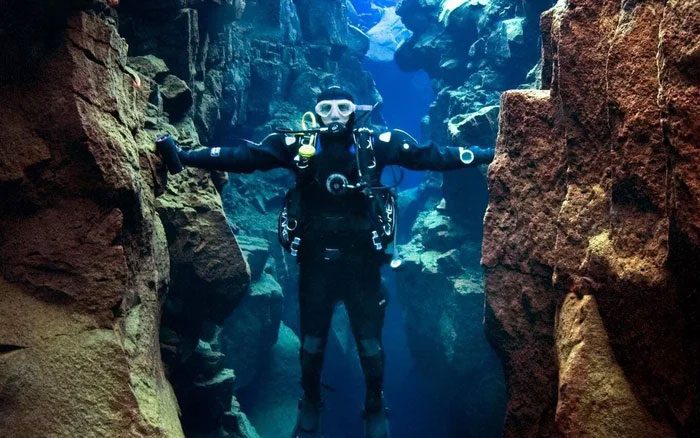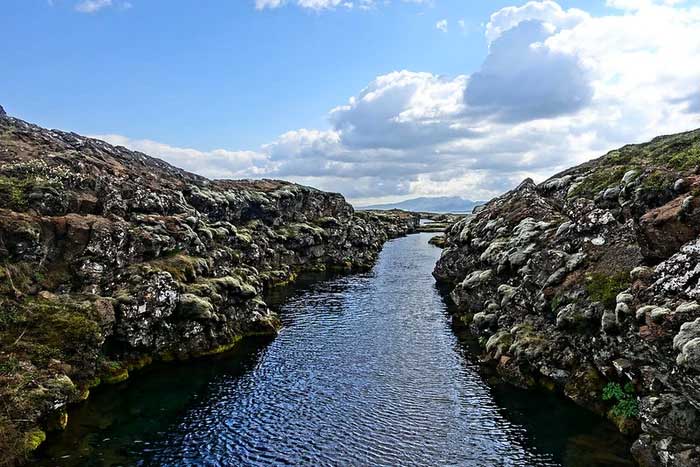The Silfra Fissure in Iceland is the only place on Earth where you can swim freely between the North American and Eurasian continents.

The Silfra Fissure opened in 1789 due to the movement of the North American and Eurasian plates.
Located in Þingvellir National Park in Iceland, the Silfra fissure is a gap formed between the North American and Eurasian tectonic plates. Simply put, this is the only location in the world where you can swim directly between the continents of North America and Europe.
The Silfra fissure opened in 1789 as a result of the movement of the North American and Eurasian plates, which run throughout Iceland. These plates are separating at a rate of approximately 2 centimeters (0.79 inches) per year. This stress is periodically relieved through major earthquakes that occur roughly every ten years, causing cracks and fissures to form in the Þingvellir valley, with Silfra being one of the largest and deepest among them.

The Silfra fissure is located in Lake Thingvallavatn at Þingvellir National Park in Iceland. A portion of the fissure lies in the Mid-Atlantic Ridge of the Atlantic Ocean, which is also where the boundary between the European and American continents is located. The Mid-Atlantic Ridge is the longest mountain range in the world, but most of it is submerged beneath the Atlantic Ocean.
This massive fissure is filled with some of the clearest water in the world—so clean and pure that it is drinkable, allowing visibility of over 100 meters underwater. The reason for this exceptional purity is the centuries-long filtration process, as the water travels to Silfra through fissures formed by the Langjökull glacier.
However, there’s a downside: the water here is extremely cold—around 35 to 39 degrees Fahrenheit year-round.

The Silfra fissure resembles a large crack on the Earth’s surface. Here, the continental plates expand about 2cm each year. Deep in the Atlantic Ocean, the fissure is not clearly visible. But at Silfra, due to the crystal clear water, divers can see clearly.
Due to the unique location, the water often appears in shades of blue and green similar to gemstones. Moreover, with such low temperatures, you might even see rainbows when sunlight refracts through the water on clear days.

This fissure can be easily observed thanks to the incredibly clear meltwater from Iceland’s glaciers. Silfra is fed by groundwater from Langjökull, Iceland’s second-largest glacier, located about 50 kilometers from Lake Thingvallavatn.

A professional diving team from the U.S. measured the maximum depth at Silfra to be 63 meters. However, many are hesitant to risk their lives diving deep into this narrow fissure, as it is one of the most geologically active sites in the world. Each year, earthquakes and volcanic activity cause the tectonic plates to shift more than 2cm apart. Nonetheless, this site attracts thousands of tourists and ocean lovers from around the world to experience the thrill of diving between two continents.

The term “silfra” in Icelandic means “silver,” referring to the frozen water. However, beneath the surface, the water displays bright blue and green hues, with the deep cobalt color of the transparent water contrasting with the neon green of seaweed clinging to the rocks. This type of algae, often referred to as “troll hair”, typically has a shape reminiscent of spaghetti.

The coldness results in a lack of marine life, making the water even clearer. The water here is so pure that it can be consumed directly without treatment.

While many have swum in the Silfra fissure, very few dare to dive deep into the Silfra rock caves, which reach a minimum depth of 63 meters. Due to the narrow passage and the loose rock structure, which could collapse if struck hard, this area contains many dangers.


















































